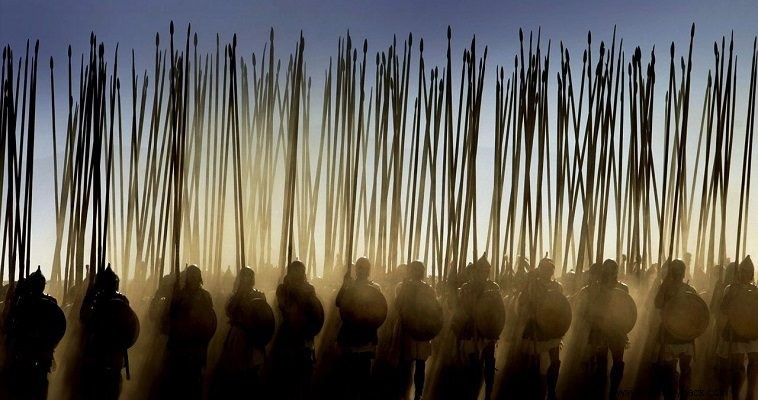
The Illyrians were an ancient people of the Balkans. Some consider them ancestors of modern Albanians, which is not proven. One of their strongest tribes was that of the Dardanians, who also founded a powerful state centered in the region of today's Kosovo and part of today's Serbia, but which particularly troubled Macedonia. However, according to Greek mythology - and Roman - the Dardanians came from Asia Minor and are associated with Troy. And their progenitor, Dardanus, was the son of Illyrio, son of Cadmus.
Beyond the myths, however, the Dardanians, especially during the reign of Vardyli, proved to be a real scourge for Macedonia, which they made a vassal with taxes in 372 BC. In 359 BC the Macedonian king Perdiccas III who campaigned against them was defeated and killed, together with 4,000 of his men, many of whom were murdered as prisoners. The situation for Macedonia was critical. What was left of the Macedonian army had fled with its morale at Nadir.
In their misfortune, however, the Macedonians were finally lucky. The deceased Perdiccas was succeeded on the throne by his younger brother Philip II (the father of Alexander the Great). From then on, things changed... Until Philip was established on the throne, he was forced to tolerate the Dardanians and Vardyli. In this way the Greek king gained the necessary time to reorganize the destroyed army of his state. Philip proceeded to resurrect his army as secretly as he could, but rumors reached the ears of Vardyli who asked Philip to respect the Illyrian conquests.
Philip, however, demanded the complete withdrawal of the Dardanians from the Macedonian lands, something which, of course, Vardylis did not accept. So war was inevitable. Philip mobilized the largest possible force of men he could, forming an army of 10,600 men (10,000 infantry and 600 cavalry). And he made his men understand that there was no other alternative than victory. Even if they were captured the Dardanians would slaughter them as they had done with Perdiccas' men in the past. The dilemma was simple... Victory or Death.
On the other hand, Vardylis gathered a similar force of 10,000 infantry and 500 cavalry. Of his infantry, 7,000 were considered elite. These men were armed with bugles , a heavy spear or heavy javelin (Greek and Roman sources call it a spear, the Souda or Suida dictionary calls it a "Roman javelin").
But Philip had also reorganized his army by forming the elite body of Defenders , whose men carried a hoplite shield, but could also carry javelins or spears and fight both "peltastically" and as hoplites. At the same time he armed the pedestrians of swept me , long spears 6 m long instead of the standard weapon spear. His cavalry consisted of noble Companions of the King horsemen, while it also had divisions of hoplites and psils. The main shortcoming of the new Macedonian army was the lack of experience, but it began to be overcome with intensive training.
The Catalytic Clash
At the head of his new army, Philip moved north in the summer of 358 BC. reaching the area of today's narrows of Kleidi in Vevi, in ancient Lyggistida. Philip moved cautiously as he faced an experienced though elderly opponent, Vardyli and his elite warriors. Coming out of the straits, Philip saw the opposing army in front of him. He immediately ordered his sarissaphoros to his left and center, while hoplites from other Greek cities and Hypaspists lined up on his right. Horsemen and lightly armed men lined up on the flanks.
The battle seems to have been fought near the city of Heraklia Lygistis, today's Bitola of the Skopian state. Diodorus Siculus mentions that Vardylis ordered his men in a square formation which is probably not true. On the contrary, the Roman Frontinus ordered his infantry in great depth against the phalanx, deploying his elite warriors in the center, having horsemen and squires on the flanks. Thus lined up, the two opposing armies began to move against each other, the Dardanians faster, the Greeks slower so as not to break their formation.
But when the Dardanians arrived before the sarissaphoros, they were pinned down, unable to break through the "forest" of spears of the Greeks. At the same time, Philip with the hoplites and the defenders began to press hard against the enemies who were fighting in a "shallow" formation. Gradually the Dardanians in this wing began to retreat under the pressure of the Greeks. At the same time the famous cavalry of the Partners rushed out and, supported by the lightly armed squires, overwhelmed the cavalry of the wars. Immediately afterwards they attacked the opposing foot soldiers who were already being suffocated by the hoplites and the Supporters from the flank and dispersed them.
The left flank of Vardyli's army collapsed and his surviving men fled, pursued by the Greeks. An attack followed and against the enemy's right which also soon collapsed, being flanked with the Dardanians seeking salvation in flight. According to Diodorus the Sicilian over 7,000 Dardanians perished in the battle. On the contrary, the Greek dead did not exceed 500 according to the most negative account. After this disastrous defeat, Vardylis immediately asked for peace by handing over all the Greek lands he possessed up to Lake Achrid in the present state of Skopje. It was only after the death of Philip that the Illyrians ventured to move again, but they found Alexander before them. .
PANTELIS D. KARYKAS
